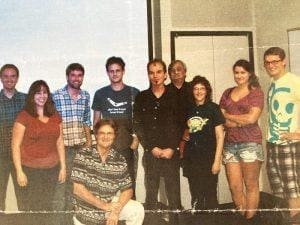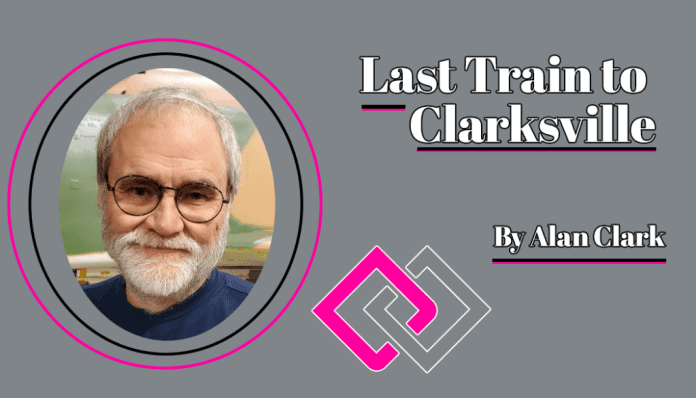Alan Clark’s cousin, Johnnie here, with a story about the day a famous movie star attended one of Evening at Emory adult and community ed classes back in 2012. That’s a college in Atlanta and I was living in nearby Decatur at the time.
Some of my most memorable Evening at Emory courses on music history were the times that a famous or at least reputable music performer made guest appearances. I had special visitors to a folk music class on two different occasions. For one of the Folk Music of the 1960s classes I arranged for John McCutcheon to visit and to bring his dulcimer. John specialized in children’s songs, receiving Grammy nominations for six of his 40 albums. While not as well-known as other sixties singer/songwriters, John was proficient on many instruments, including banjo, fiddle, autoharp and especially the hammered dulcimer. Which he demonstrated beautifully for us at the end of the class session.
Frank Hamilton, the other folk singer who made a guest appearance, may not be a household name, but the civil rights anthem for which he wrote the music is legendary. I met Frank when someone at my church told me that she lived just down the street from the man who co-wrote We Shall Overcome and gave me Frank’s contact information. I gave him a call, took him out to lunch and a couple of months later there he was in my 1950s Folk Music class, telling stories of giving Woody Guthrie banjo lessons and replacing his friend Pete Seeger in the Weavers in 1963.
 But the most famous guest I ever welcomed to an Evening at Emory class was not a musician, but a movie star and his visit was totally unexpected. The class was called The Creative Explosion: Popular Music from 1965-1970. For this one I had enlisted Colonel Bruce Hampton, a very colorful Atlanta musician whose backing group was called the Aquarium Rescue Unit. Bruce had agreed to speak to the class during Week Two, which featured the music of the Velvet Underground, Frank Zappa and the Beatles, among others. Bruce had known Zappa personally as well as another eccentric recording artist, Captain Beefheart and had released his own Columbia Records double-pocket album Music to Eat with his Hampton Grease Band in 1971. The group had opened for such famous groups as the Grateful Dead and the Allman Brothers, so my plan was to have Bruce share his reflections on the music scene of the late sixties and early seventies, especially the musicians that he had known personally. During the first hour of the class, he regaled us with some great stories of all the musicians I’ve mentioned here and plenty more.
But the most famous guest I ever welcomed to an Evening at Emory class was not a musician, but a movie star and his visit was totally unexpected. The class was called The Creative Explosion: Popular Music from 1965-1970. For this one I had enlisted Colonel Bruce Hampton, a very colorful Atlanta musician whose backing group was called the Aquarium Rescue Unit. Bruce had agreed to speak to the class during Week Two, which featured the music of the Velvet Underground, Frank Zappa and the Beatles, among others. Bruce had known Zappa personally as well as another eccentric recording artist, Captain Beefheart and had released his own Columbia Records double-pocket album Music to Eat with his Hampton Grease Band in 1971. The group had opened for such famous groups as the Grateful Dead and the Allman Brothers, so my plan was to have Bruce share his reflections on the music scene of the late sixties and early seventies, especially the musicians that he had known personally. During the first hour of the class, he regaled us with some great stories of all the musicians I’ve mentioned here and plenty more.
Around the halfway point of the two-hour class, I let everyone take a few minutes to make a trip to the bathroom or water fountain. And I approached Bruce with a question and a concern. “Thanks so, so much for your contribution to the class tonight, Bruce. But I couldn’t help but notice that after you were done speaking you seemed to be on the phone a few times. Is everything OK? Are you needed at home? Do you need to skip the last hour of the class?”
“No, nothing like that,” replied Bruce. “But I had lunch today with an old friend of mine who is in town, and I told him about this class and invited him to join us for part of it. He was up in Kennesaw, scouting out the town as a possible location for his new movie. I hope that’s alright.” I asked him who the friend might be. “It’s Billy Bob Thornton.”
My jaw dropped so far it almost became unhinged. “Whaaaaat? How in the heck do you know him, Bruce? What I mean to say is that it’s fine with me if he visits the class.”
“He was the singer in one of my ill-fated bands of the 1980s and has actually gone on to make some of his own albums recently. He and his cameraman were done scoping out the site for his next film (it was called Jayne Mansfield’s Car and ended up being shot in Cedartown, Georgia) and wanted to attend this class. He and his cameraman buddy, J.D. made it as far as the Emory campus but couldn’t find the building, so I had to give them some directions.”
About this time in walks Thornton and J.D. You may think of Billy Bob as skinny, but I would call him downright spindly (check out the picture). Sporting a soul patch and dressed all in black, he’d entered the room and ambled on over to greet Bruce. I joined them, introductions were made, pleasantries exchanged, and I continued with the class. At that point I introduced our honored guest and let him make a few comments, including, “I’m really sorry I missed the part about Frank Zappa. That’s the music I put on the stereo when I’m working on a screenplay.”
The class continued with music and video clips of some of the more famous progressive rock groups like Procol Harum, the Moody Blues, King Crimson, Yes and Emerson, Lake and Palmer and closed with segment on the significance of the
Velvet Underground. Billy Bob had asked questions and made a few comments along the way, closing with these words, “Gee, I wish we had courses like this back when I went to school. It might have kept me from dropping out after two semesters.”
Billy Bob Thornton graciously stuck around for another half hour after the class was over, chatting film, signing autographs and posing for this picture. That’s me kneeling down front and the late Col Bruce Hampton just over Billy Bob’s right shoulder.
Quick note – John Alan Clark is my first cousin. John is a music historian who is also a great communicator. I have asked him to occasionally contribute to the Clarksville column because he has lived a rich and varied life, replete with great adventures and subsequent stories.






